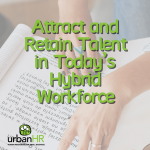
Attract and Retain Talent in Today’s Hybrid Workforce
Organisations are finally bouncing back from the pandemic, with some experiencing more growth than ever before! However, this raises the question – how do we navigate a high growth environment in the new hybrid workplace?
#1. Involve Company Leaders in Early Hiring Stage
Research has shown that organisations that involve executives in the earlier hiring stages, were often more successful at closing great candidates. Why?
The executives have a deeper understanding of the culture they’re trying to build which translates into their ability to select prospective employees who match the culture as well as adding their unique contributions and experiences.

Of course, organisations will reach a point where having an executive present in the earlier stages won’t be feasible, but we suggest instead, have a culture champion present to speak with the candidates.
This adds objectivity to the process and increases your chances of hiring talent that will strengthen your culture.

#2. Grow and Develop Existing Talent
The manager-employee relationship is one of the most important partnerships at a company. Employers play a pivotal role in an employee’s career growth, in addition to their sense of inclusion and belonging within an organisation.
It is critical to recognise and value existing team members during periods of hyper-growth.
Whether it’s implementing a spot recognition program, or simply giving shout-outs, leaders must find ways to raise visibility around the contribution of high performing employees. This is especially important for remote workers!
Schedule regular 1:1 meetings and ask what skills they would like to develop. Here are a few examples you can use to kick-start that process:
- What parts of your job are most interesting and rewarding?
- What areas are you finding most challenging right now?
- What are you doing to reach short- and long-term career goals?
- Are there any other projects, committees, or additional responsibilities you would like to be a part of?
- Is there anything else you’re curious about that you haven’t been able to explore yet?
#3. Be Explicit, Rather than Implicit
We encourage that throughout the employee lifecycle, managers should be as clear as possible about their expectations, how their contributions impact the company, and what that accomplishes for the employee.
Feelings of inclusion and belonging are fundamental to providing employees with clarity to their role and purpose in the organisation.

Reinforcing shared values allows people to understand why what they do is important.
Many leaders fall into the trap of being too busy and assuming employees will figure it out on their own. Try not to leave things unsaid and remind the employees of their impact within the organisation

#4. Benefits You’ve Got to Be Offering
In today’s society, a good salary and casual Fridays are no longer enough to recruit and retain employees in a hybrid environment.
Successful employers will offer the right type of leadership, find their ways to make themselves a great place to work and invest in employee relationships.
So what benefits are employees wanting? Here are some of our suggestions!
- Paid Annual leave – the more paid leave they get, the less likely they’ll suffer from burnout and in turn, be more satisfied
- Flexitime/ sabbatical – employees would rather Flexi/ pick their hours than having a pay rise. Allow them to work from anywhere, any time and take breaks to maintain a better work-life balance
- Casual dress code – many companies are adopting a casual approach to dress code. One key benefit is the impact on employee morale. This provides them with the freedom to express their individuality and demonstrate a commitment to be more creative and resourceful.
Providing development opportunities also increases an employee’s loyalty to the company, making them happy and valued for the investment that the company is providing to them. This could simply be providing increased responsibility indicating that as an employer, you feel that your employee is ready for a more significant role.
Providing career development to employees is super effective as employees can utilise these skills over the course of their careers.
#5. Be Aware of Unconcious Bias
Humans are inherently biased. In a hybrid workplace, this can translate into multiple scenarios such as a manager giving a promotion to an employee who comes into the office more often, as opposed to a remote employee.
It is pivotal to recognise our unconscious biases and overcome these preferences by basing our evaluation on objective metrics and outcomes, rather than feelings and perceptions.

By improving one’s awareness and understanding of unconscious bias, individuals can begin to change how they think about and engage with diversity issues. Be sure to step back and ask:
• What biases might I have?
• What impact does this have in the workplace?
• What will I do about this?
Increasing one’s awareness and engaging in productive dialogue is the first step in the journey of creating a globally inclusive workplace.
As always, should you need some help, please get in touch.





















































